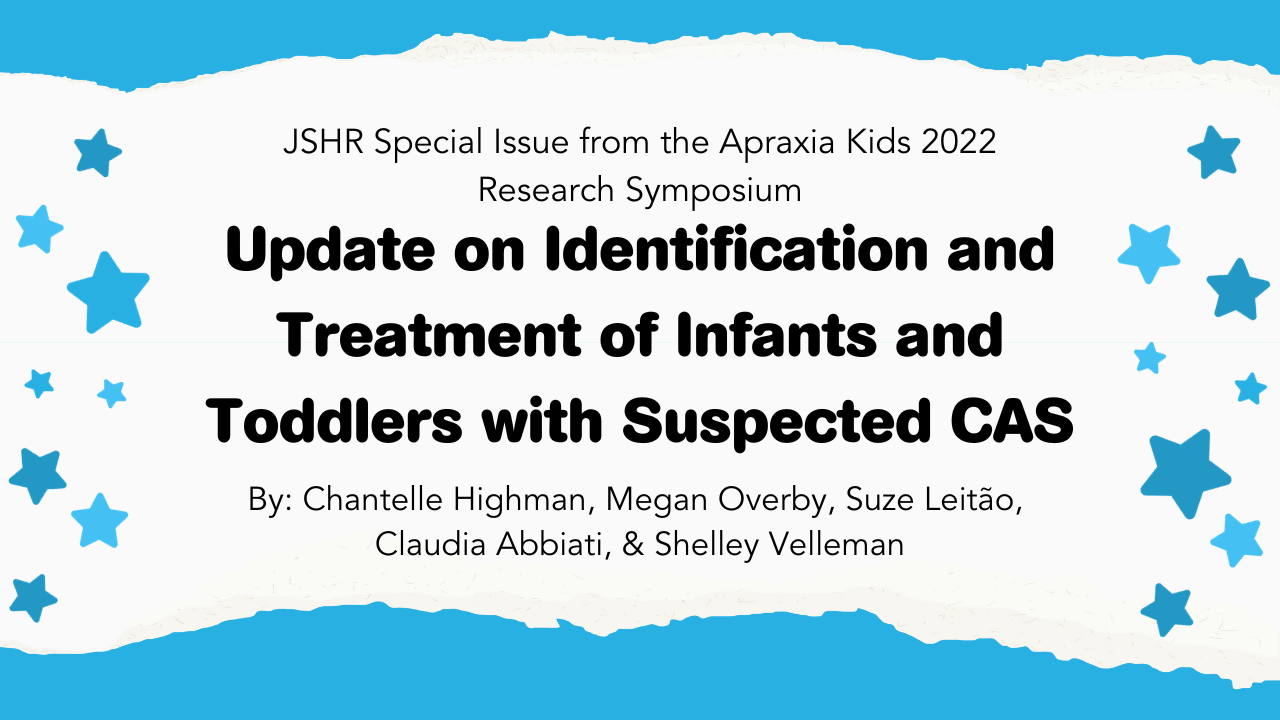
01 Dec Update on Identification and Treatment of Infants and Toddlers with Suspected CAS
Summary by Chantelle Highman
Parents and SLPs often want to get started with early intervention for children with CAS as soon as they can. It can be difficult to know how to do this before you can be sure about a diagnosis. But treating children as early as possible is important for taking advantage of the many changes occurring in young brains. Research is now available to help clinicians assess and treat very young children, even infants and toddlers, when CAS is “suspected” but not diagnosed. This article summarizes this research, to help SLPs working with children 2 years old and younger.
CAS often goes with expressive language delay, other neurodevelopmental disorders, and sometimes a family history of CAS. When a speech-language pathologist assesses an infant or toddler with suspected CAS, the clinician should look for: (a) a limited variety of consonants and vowels, (b) limited babbling, (c) less frequent vocalizations, and (d) simpler babbles (for example, only one consonant or one vowel at a time). The authors suggest clinicians should assess a young child with suspected CAS by getting (a) a full case history from the caregivers, (b), an early language test, and (c) a sample of the child’s speech in play to see how often they try to communicate and how they do so (especially for the symptoms listed above). It is usually not possible to know for sure if a very young child has CAS until they can produce enough speech to check for some of the signs. However, SLPs can still get started with treatment.
Studies have been done on treating infants and toddlers at high risk for motor speech difficulties (including CAS). They have had success with infants whose parents are trained on how to encourage the child’s early sounds. Repeating the child’s sounds and expanding on them (phonetic contingency) is one of the activities parents learn. Two studies of toddlers with suspected motor speech difficulties also showed that parent training led to increased use of speech sounds. Another study with young children with CAS found that early therapy with multisensory cueing (voice, gestures, etc.) was more successful twice a week than once a week for improving speech and functional communication.
The article provides clinicians with specific evidence-based treatment recommendations for infants and toddlers with suspected CAS: (1) you can start therapy even before a conclusive diagnosis can be made, (b) use a team approach (work with a PT, OT, pediatrician, geneticist, early interventionist, and/or a developmental psychologist, as appropriate for the child), (c) train caregivers, (d) use phonetic contingency, (e) use multisensory cueing, and (f) build on the child’s current productions.
Highman, C., Overby, M., Leitão, S., Abbiati, C., & Velleman, S. (2023). Update on Identification and Treatment of Infants and Toddlers With Suspected Childhood Apraxia of Speech. Journal of Speech, Language, and Hearing Research, 1-21. https://pubs.asha.org/doi/10.1044/2023_JSLHR-22-00639
Summary by Chantelle Highman
Parents and SLPs often want to get started with early intervention for children with CAS as soon as they can. It can be difficult to know how to do this before you can be sure about a diagnosis. But treating children as early as possible is important for taking advantage of the many changes occurring in young brains. Research is now available to help clinicians assess and treat very young children, even infants and toddlers, when CAS is “suspected” but not diagnosed. This article summarizes this research, to help SLPs working with children 2 years old and younger.
CAS often goes with expressive language delay, other neurodevelopmental disorders, and sometimes a family history of CAS. When a speech-language pathologist assesses an infant or toddler with suspected CAS, the clinician should look for: (a) a limited variety of consonants and vowels, (b) limited babbling, (c) less frequent vocalizations, and (d) simpler babbles (for example, only one consonant or one vowel at a time). The authors suggest clinicians should assess a young child with suspected CAS by getting (a) a full case history from the caregivers, (b), an early language test, and (c) a sample of the child’s speech in play to see how often they try to communicate and how they do so (especially for the symptoms listed above). It is usually not possible to know for sure if a very young child has CAS until they can produce enough speech to check for some of the signs. However, SLPs can still get started with treatment.
Studies have been done on treating infants and toddlers at high risk for motor speech difficulties (including CAS). They have had success with infants whose parents are trained on how to encourage the child’s early sounds. Repeating the child’s sounds and expanding on them (phonetic contingency) is one of the activities parents learn. Two studies of toddlers with suspected motor speech difficulties also showed that parent training led to increased use of speech sounds. Another study with young children with CAS found that early therapy with multisensory cueing (voice, gestures, etc.) was more successful twice a week than once a week for improving speech and functional communication.
The article provides clinicians with specific evidence-based treatment recommendations for infants and toddlers with suspected CAS: (1) you can start therapy even before a conclusive diagnosis can be made, (b) use a team approach (work with a PT, OT, pediatrician, geneticist, early interventionist, and/or a developmental psychologist, as appropriate for the child), (c) train caregivers, (d) use phonetic contingency, (e) use multisensory cueing, and (f) build on the child’s current productions.
Highman, C., Overby, M., Leitão, S., Abbiati, C., & Velleman, S. (2023). Update on Identification and Treatment of Infants and Toddlers With Suspected Childhood Apraxia of Speech. Journal of Speech, Language, and Hearing Research, 1-21. https://pubs.asha.org/doi/10.1044/2023_JSLHR-22-00639
Credentials:
Hours of Operation:
Treatment locations:
Address:
,
Phone:
Email:
Overall Treatment Approach:
Percent of CAS cases:
Parent Involvement:
Community Involvement:
Professional consultation/collaboration:
Min Age Treated:
Max Age Treated:
Insurance Accepted:




